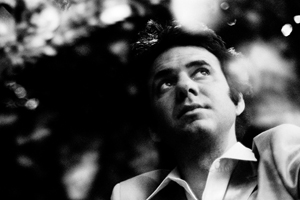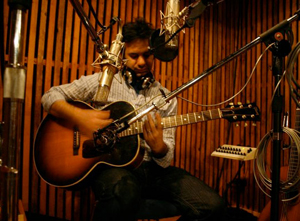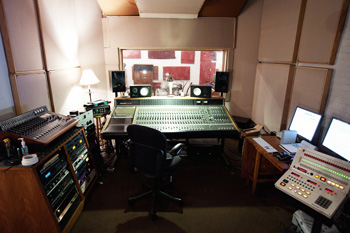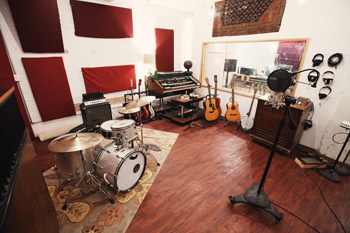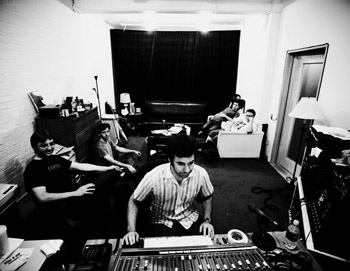Studio Project: Steve Salett and Gary Maurer on The Poison Tree & Saltlands Studios
DUMBO, BROOKLYN: In an era when a record’s “production” often overwhelms its “performances” – for better or for worse – a worthy and well-recorded live performance can sound like a revelation. The newly released, self-titled album by The Poison Tree, a Brooklyn-based project led by former King of France frontman and producer Steve Salett, captures performances so worthy and so well that it actually feels familiar, forges an instant connection.
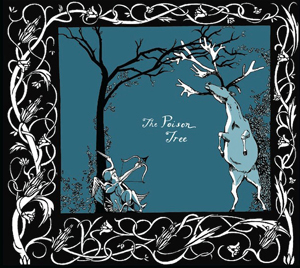
The Poison Tree’s self-titled album is available now at iTunes
What feels so right here? The immediacy of Salett’s deep baritone vocal, his nylon string guitar, and the sparse but essential ensemble including Thomas Bartlett (Doveman) on keys, Jeff Hill (Rufus Wainwright) on upright/bass and drummer Konrad Meissner (Graham Parker) captured in the perfect room (Sear Sound) by a skilled engineer/producer, Gary Maurer (HEM). The songs are intimate and wistful, lyrically driven and cinematic, and the music is a sophisticated spin on folk-acoustic-jazz. Timeless.
According to Salett, The Poison Tree was awhile in the making, both before and after the two days of tracking at Sear Sound in January of ’09.
They mixed the album over several weeks in Brooklyn at Saltlands, the recording collective Salett operates with Maurer and two other musician/engineer/producer partners — Dawn Landes and Eli Janney.
Salett also runs the adjacent 10,000 square feet of production/rehearsal spaces known as the Saltmines, and the ‘collective’ extends to include his many tenants. The sprawling basement facility is like its own little sub-set of the Brooklyn music scene, an underground coop where multi-dexterous music and recording professionals share gear, swap techniques, play on each other’s projects and book each other’s rooms.
We sat down with Salett and Maurer in Saltlands, a fully functional recording and mixing room where artists like The Soft Pack, Obits, Alexi Murdoch and The National have recently recorded. Like The Poison Tree music, this studio is real and unpretentious – made by friends.
We are big fans of The Poison Tree record. Tell us, what was the inspiration behind this project and the sound?
Steve: I wanted to write songs that were like the very first songs I wrote, before I started trying to have an indie rock band and chase certain sounds. I was writing folkier tunes. So I wanted to do that kind of record.
Also, I’d always wanted to write something fast and slow at the same time. There are so many things I’m inspired by that I wanted to do it all. I wanted it to be lyrically driven. I wanted it to have very simple arrangements. I wanted to focus on the sonics of it. I was excited to use tape and to really think about the songs. I felt like I’d never made a record that sounded to me like the records I loved. They just never sounded good enough to me.
As I learned more about recording and producing, and I’ve learned a lot from Gary – I realize that a great sounding record is very much about performance. It’s about capturing good players playing thoughtful parts. Do that and it will sound good!
What was the approach going into the studio? Musically, sonically, what was the direction?
Gary: One of the early definitions of this project was that this was not going to be an indie rock record. In fact, this record has nothing to do with indie rock. The original idea was to go to Sear Sound for two days with this four piece, all acoustic band and just record these guys playing the songs. And that’s how it started. It was totally simple. It was all about the vocal performance.
Steve: It was a lot of live takes. And even though we worked on the record for a long time, we were working on pretty small changes, or adding stuff that we ultimately got rid of in favor of the live take. It’s funny to work so hard on something that was already there!
Gary: But it’s an easy trap to fall into. You figure: I’m a producer — isn’t it my job to put stuff on there? Isn’t that the work? I’ve made a conscious effort for a long time to get away from that – with HEM and other projects – saying we’re not going to do overdubs, we’re just going to play. The Poison Tree group of songs are so much about the lyrics and the stories that a lot of the other stuff we tried just ended up feeling like it was detracting from that.
Why was Sear Sound the right studio for this project?
Gary: Sear Sound is a place where I’ve worked a lot since the 90s. For the kind of record we were talking about, this kind of ensemble – upright bass, piano, drums, Steve playing nylon string guitar and singing – it was the natural choice. At Sear Sound, there’s no impediment to getting that on the tape. You walk in and everything is ready to go. I’ve worked with those guys for years. I can send them a mic list, and when we walk in it’s all ready to go.
Steve: Also, we really wanted tape. And we didn’t have a tape machine at that time. We recorded to 2” 16-track. (Gary: Also Walter had some 996 hidden away that we bought off of him to use on this!)
I remember the process like: OK, we want the record on tape. Can we do it here [at Saltlands]? At that time we didn’t have a piano. We didn’t have a tape deck. So we started to think – what do we need to buy to get set up to do the record here instead of spending the money on Sear Sound? And in that process you realize just how good Sear Sound is! (laughs) It’s incredible. The equipment, the microphones, at that time Walter…
Gary: Yeah. I mean just the signal path for the vocal chain alone: chrome long-body Neumann U47 with a Pultec MB-1A preamp and an original LA2A that Walter bought new in the box going to 15 ips 16” 2-track. I mean…what more do you want? Listen to those vocals – it sounds like Leonard Cohen. And I take no credit for it: that was Steve and Walter. I had nothing to do with it!
So you were working with these great players – were these arrangements all written and rehearsed ahead of time, or was it more collaborative with you guys trying different ideas in the studio.
Steve: I had a good idea what I wanted and we did pre-production and recorded all the parts. And we rehearsed. Gary was really instrumental in helping to shape the songs. But when it was time to go, some of that went out the window and we just played.
On certain songs, like “Welcome to the Neighborhood,” it seems like there’s so much going on and it’s really just me, upright bass, piano and CJ Camerieri (trumpet player) came in and put down some horns. That was it.
And that was exactly the type of thing I wanted to get to, which took me a long time to realize – that it’s not really about trying to add all these things. It sounds so full as it is. Just left alone, an upright bass is a very rich and full instrument.
And you can hear the space too.
Gary: Right and the space that’s allowed for the melody and the vocal is just wonderful.
Sounds like you took some time with the mixing – what was your approach on that? Staying true to the live performances?
Gary: We wanted to concentrate on really getting to the emotional core of the performance. I tried to concentrate more on revealing that – what was truly important about the performance – than worrying about ‘oh, can you hear the hi-hat there?’ I tried to concentrate on what it felt like. What would feel the most emotionally impactful.
I love Steve’s lyrics and voice, and so I wanted to make that as immediate as possible. Is it sort of loud at 80Hz? Who cares! The more I could shut off the technical part of my brain, the more I liked what was going on. The way you hear the song is what your original intent was. You’re not focusing on how loud the snare drum is. It’s about what is the intent of the song.
Steve: And it’s funny because, as we were working on it, when something sounded wrong, we would have an emotional reaction to it. It would piss us off! It’s a funny way to work – to try to listen for that – because there is no science to that.
If this is all about amazing vocal performances and lyrics, I would think that the feeling would be there right away. So what was all the tweaking and experimenting about?
Gary: Maybe a lot of the experimentation was about trying to hear all the parts. Again, a good example of this is the song “Welcome to the Neighborhood” – which was going to be this whole ridiculous orchestrated thing – and a lot of the experimentation there was us adding and then getting rid of things.
Steve: It’s part of the process because I think it’s scary to have your songs just laid out there very clearly.
Gary: Yeah. I think there is that element of commitment and belief in the songs and the more we believed in it, the less stuff we needed to add, the more stuff we ended up leaving on the floor.
And it’s difficult to know when a part, no matter how much you love it, is detracting from that moment rather than enhancing it.
Gary: It is! And it seems like the job of the modern producer often comes down to finding more interesting things to put in the song – a lot of times things that are just like every other song that came out in the last 6 months. We really were trying very hard to get away from that as much as possible. And just make it about Steve’s songwriting and singing.
To me there’s a big line between what I refer to as performance records and what I call production records. I don’t like working on production records anymore. It’s tedious, and the same ideas get recycled in terms of arrangements and overdubs, over and over.
And then there are performance records. And they’re very difficult to copy because it’s this original thing. This group of songs is the most original group of songs I’ve heard in 20 years. You can’t rip that off. And when you can manage that, you don’t have to worry about ‘should I turn on the tremolo pedal or not?’ It doesn’t matter!
Good songs and good players makes a producer’s job….the best advice Lenny Waronker ever gave me: “Just always work with the best musicians you can. Then you don’t have to ‘produce’ anything.”
Great advice. Now switching gears, let’s talk bit about Saltlands. Steve, you are also an engineer and producer, yes?
Steve: Yes, I’m new to the game certainly, but I did get pretty crazy about it. It’s a great experience to build a studio and work with these people. Gary’s been very good about teaching me a lot. And you learn a lot about the gear it when it breaks!
[Saltlands is equipped with a Neotek Elite 32 Channel Console and Neve 54 12-Channel Sidecar with Purple Audio Balanced Track Outputs, Pro Tools HD2 and a highly configurable recording space. Says the studio: “The gear in the studio has been chosen with a selectivity gained from the years of professional experience of the Saltlands partners.” And in that regard, the gear collection is being refined and augmented all the time.]
And the studio has been booked commercially a fair amount, right? How does the business vs. collective work out for everyone involved?
Steve: Most of what we do is commercial – for paying clients. But the Saltlands is a collection of a lot of people’s gear and time. The rehearsal rooms occupy about 10,000 square feet down here – 16 rooms. Many of those have turned into little private studios.
Then there’s a part of it where some of us do ad work and can be hired like a music house. We’re also building a music library.
Cool. Sure would seem there’s no shortage of original music around here – makes sense to go after some of that work…
Steve: Absolutely. And a lot of people are doing this now, and that makes sense. I think there’s definitely a division between people’s art – their music – and the craft of writing for commercials which is totally different. You’re doing what someone else wants. But in my experience it certainly helps you think about getting to what you want to do.
Interesting. So do you think that the writing you do for commercials and TV has any influence over what and how you do for art’s sake, or vice versa?
Steve: Yeah, I think maybe at least in the way that I feel more secure or confident in how I approach things. I know that I can write to a specific direction successfully without feeling like I’m being led by the nose with my inspiration. I can kind of direct it more.
Gary: It’s a really good exercise to do work for hire – it’s actually sort of liberating. You judge what you’re writing in a totally different way than something that goes on your album. It’s like a functional exercise. You know how it’s going to be judged, which is totally outside of what art criticism is. I love writing that stuff.
Steve: Also I think there is a whole kind of ‘school,’ or approach, to this work as a craft. This whole experience at Saltlands is one where everybody makes everybody better. And that’s really great. All the engineers who are partners have been musicians for a long time and either focus more on engineering/producing now, or balance music and engineering.
And coming at it from that angle can distinguish Saltlands from other ‘music houses,’ just in that you’re all actively artists as well as writers and engineers. There aren’t too many people bridging those worlds really effectively.
It can be hard to navigate [for those of us not coming from the traditional music house] but I think you just have to take on the things that you really want to do. A lot of times you’ll get some kind of project for a commercial where they’re like ‘make it like this song.’ And I hate that because whether I like the song or not, that is someone else’s song. That’s stealing. And I’m not going to do that.
I think the easiest way to approach a commercial is to make it something you like. I know there’s this other force, where you want to do exactly what people want. But if you can’t stand behind it, it’s not worth it.
For more on Steve Salett, Gary Maurer and Saltlands, visit http://saltlands.com. And follow The Poison Tree via Facebook and Twitter. Download The Poison Tree record at iTunes.







